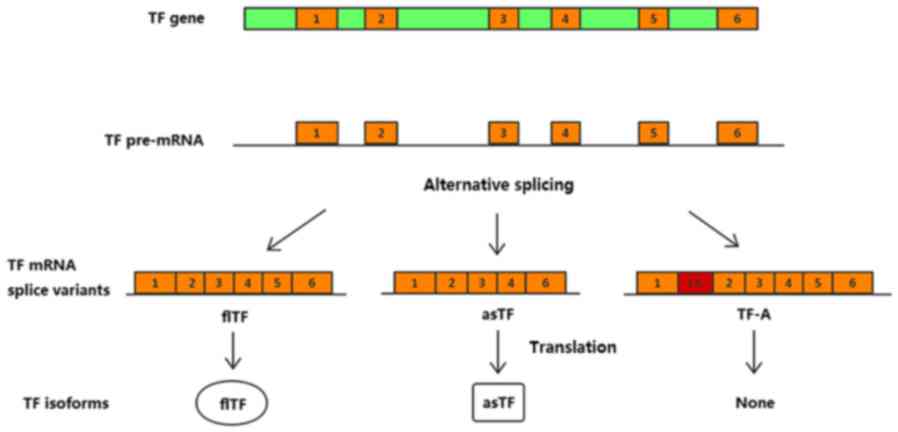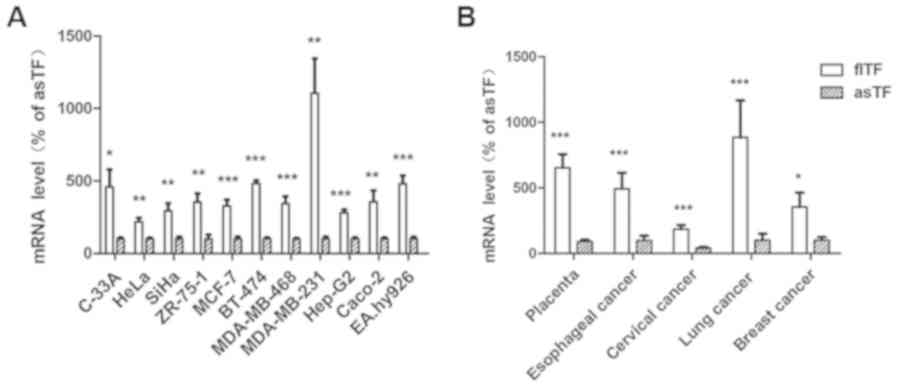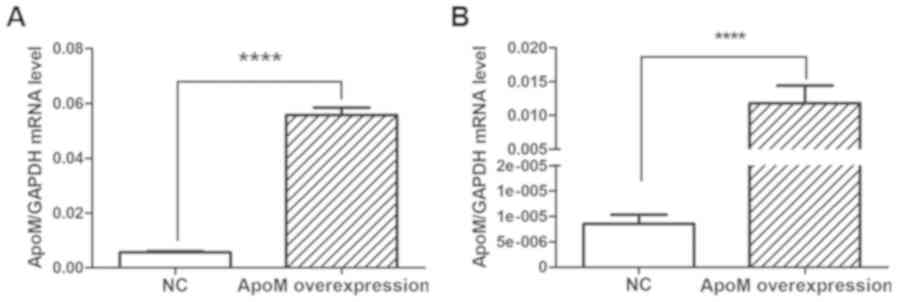|
1
|
Eisenreich A, Boltzen U, Malz R,
Schultheiss HP and Rauch U: Overexpression of alternatively spliced
tissue factor induces the pro-angiogenic properties of murine
cardiomyocytic HL-1 cells. Circ J. 75:1235–1242. 2011. View Article : Google Scholar : PubMed/NCBI
|
|
2
|
Leppert U and Eisenreich A: The role of
tissue factor isoforms in cancer biology. Int J Cancer.
137:497–503. 2015. View Article : Google Scholar : PubMed/NCBI
|
|
3
|
Boltzen U, Eisenreich A, Antoniak S,
Weithaeuser A, Fechner H, Poller W, Schultheiss HP, Mackman N and
Rauch U: Alternatively spliced tissue factor and full-length tissue
factor protect cardiomyocytes against TNF-α-induced apoptosis. J
Mol Cell Cardiol. 52:1056–1065. 2012. View Article : Google Scholar : PubMed/NCBI
|
|
4
|
Eisenreich A: Regulation of vascular
function on posttranscriptional level. Thrombosis 2013.
9487652013.
|
|
5
|
van den Berg YW, van den Hengel LG, Myers
HR, Ayachi O, Jordanova E, Ruf W, Spek CA, Reitsma PH, Bogdanov VY
and Versteeg HH: Alternatively spliced tissue factor induces
angiogenesis through integrin ligation. Proc Natl Acad Sci USA.
106:19497–19502. 2009. View Article : Google Scholar : PubMed/NCBI
|
|
6
|
Chand HS, Ness SA and Kisiel W:
Identification of a novel human tissue factor splice variant that
is upregulated in tumor cells. Int J Cancer. 118:1713–1720. 2006.
View Article : Google Scholar : PubMed/NCBI
|
|
7
|
Eisenreich A, Bogdanov VY, Zakrzewicz A,
Pries A, Antoniak S, Poller W, Schultheiss HP and Rauch U:
Cdc2-like kinases and DNA topoisomerase I regulate alternative
splicing of tissue factor in human endothelial cells. Circ Res.
104:589–599. 2009. View Article : Google Scholar : PubMed/NCBI
|
|
8
|
Han X, Guo B, Li Y and Zhu B: Tissue
factor in tumor microenvironment: A systematic review. J Hematol
Oncol. 7:542014. View Article : Google Scholar : PubMed/NCBI
|
|
9
|
Kundu S, Bansal S, Muthukumarasamy KM,
Sachidanandan C, Motiani RK and Bajaj A: Deciphering the role of
hydrophobic and hydrophilic bile acids in angiogenesis using in
vitro and in vivo model systems. Medchemcomm. 8:2248–2257. 2017.
View Article : Google Scholar : PubMed/NCBI
|
|
10
|
Xu N and Dahlbäck B: A novel human
apolipoprotein (apoM). J Biol Chem. 274:31286–31290. 1999.
View Article : Google Scholar : PubMed/NCBI
|
|
11
|
Ahmad A, Sundquist K, Zöller B, Dahlbäck
B, Svensson PJ, Sundquist J and Memon AA: Identification of
polymorphisms in apolipoprotein M gene and their relationship with
risk of recurrent venous thromboembolism. Thromb Haemost.
116:432–441. 2016. View Article : Google Scholar : PubMed/NCBI
|
|
12
|
Nádró B, Juhász L, Szentpéteri A, Páll D,
Paragh G and Harangi M: The role of apolipoprotein M and
sphingosine 1-phosphate axis in the prevention of atherosclerosis.
Orv Hetil. 159:168–175. 2018.(In Hungarian). View Article : Google Scholar : PubMed/NCBI
|
|
13
|
Zhu Y, Luo G, Jiang B, Yu M, Feng Y, Wang
M, Xu N and Zhang X: Apolipoprotein M promotes proliferation and
invasion in non-small cell lung cancers via upregulating S1PR1 and
activating the ERK1/2 and PI3K/AKT signaling pathways. Biochem
Biophys Res Commun. 501:520–526. 2018. View Article : Google Scholar : PubMed/NCBI
|
|
14
|
Livak KJ and Schmittgen TD: Analysis of
relative gene expression data using real-time quantitative PCR and
the 2(-Delta Delta C(T)) method. Methods. 25:402–408. 2001.
View Article : Google Scholar : PubMed/NCBI
|
|
15
|
Rossiello MR, Rotunno C, Coluccia A,
Carratù MR, Di Santo A, Evangelista V, Semeraro N and Colucci M:
Ochratoxin A inhibits the production of tissue factor and
plasminogen activator inhibitor-2 by human blood mononuclear cells:
Another potential mechanism of immune-suppression. Toxicol Appl
Pharmacol. 229:227–231. 2008. View Article : Google Scholar : PubMed/NCBI
|
|
16
|
Sovershaev MA, Lind KF, Devold H,
Jørgensen TØ, Hansen JB, Østerud B and Egorina EM: No evidence for
the presence of tissue factor in high-purity preparations of
immunologically isolated eosinophils. J Thromb Haemost.
6:1742–1749. 2008. View Article : Google Scholar : PubMed/NCBI
|
|
17
|
Regina S, Rollin J, Bléchet C, Iochmann S,
Reverdiau P and Gruel Y: Tissue factor expression in non-small cell
lung cancer: Relationship with vascular endothelial growth factor
expression, microvascular density, and K-ras mutation. J Thorac
Oncol. 3:689–697. 2008. View Article : Google Scholar : PubMed/NCBI
|
|
18
|
Plotkowski MC, Feliciano LF, Machado GB,
Cunha LG Jr, Freitas C, Saliba AM and de Assis MC: ExoU-induced
procoagulant activity in pseudomonas aeruginosa-infected airway
cells. Eur Respir J. 32:1591–1598. 2008. View Article : Google Scholar : PubMed/NCBI
|
|
19
|
Liu F, Huang R, Yao J, Wei W, Hu Y, Song S
and Li J: Homocysteine-induced enhanced expression of tissue factor
in human vascular smooth muscle cells. J Huazhong Univ Sci
Technolog Med Sci. 28:520–524. 2008. View Article : Google Scholar : PubMed/NCBI
|
|
20
|
Usui M, Kuriyama N, Kisawada M, Hamada T,
Mizuno S, Sakurai H, Tabata M, Imai H, Okamoto K, Uemoto S and
Isaji S: Tissue factor expression demonstrates severe sinusoidal
endothelial cell damage during rejection after living-donor liver
transplantation. J Hepatobiliary Pancreat Surg. 16:513–520. 2009.
View Article : Google Scholar : PubMed/NCBI
|
|
21
|
Lockwood CJ, Murk W, Kayisli UA,
Buchwalder LF, Huang ST, Funai EF, Krikun G and Schatz F: Progestin
and thrombin regulate tissue factor expression in human term
decidual cells. J Clin Endocrinol Metab. 94:2164–2170. 2009.
View Article : Google Scholar : PubMed/NCBI
|
|
22
|
Di Stefano R, Barsotti MC, Armani C,
Santoni T, Lorenzet R, Balbarini A and Celi A: Human peripheral
blood endothelial progenitor cells synthesize and express
functionally active tissue factor. Thromb Res. 123:925–930. 2009.
View Article : Google Scholar : PubMed/NCBI
|
|
23
|
Wang HJ, Huang H, Chuang YC and Huang HC:
Paclitaxel induces up-regulation of tissue factor in human aortic
endothelial cells. Int Immunopharmacol. 9:144–147. 2009. View Article : Google Scholar : PubMed/NCBI
|
|
24
|
Wang HJ, Lo WY, Lu TL and Huang H:
(−)-Epigallocatechin-3-gallate decreases
thrombin/paclitaxel-induced endothelial tissue factor expression
via the inhibition of c-Jun terminal NH2 kinase phosphorylation.
Biochem Biophys Res Commun. 391:716–721. 2010. View Article : Google Scholar : PubMed/NCBI
|
|
25
|
Teng Y, Jiang R, Lin Q, Ding C and Ye Z:
The relationship between plasma and placental tissue factor, and
tissue factor pathway inhibitors in severe pre-eclampsia patients.
Thromb Res. 126:e41–45. 2010. View Article : Google Scholar : PubMed/NCBI
|
|
26
|
Valsami S, Ruf W, Leikauf MS, Madon J,
Kaech A and Asmis LM: Immunomodulatory drugs increase endothelial
tissue factor expression in vitro. Thromb Res. 127:264–271. 2011.
View Article : Google Scholar : PubMed/NCBI
|
|
27
|
Blank M, Baraam L, Eisenstein M, Fridkin
M, Dardik R, Heldman Y, Katchalski-Katzir E and Shoenfeld Y:
β2-Glycoprotein-I based peptide regulate endothelial-cells
tissue-factor expression via negative regulation of pGSK3β
expression and reduces experimental-antiphospholipid-syndrome. J
Autoimmun. 37:8–17. 2011. View Article : Google Scholar : PubMed/NCBI
|
|
28
|
Ben-Hadj-Khalifa S, Hézard N, Almawi WY,
Lakbakbi S, Macé C, Cornillet-Lefebvre P, Mahjoub T and Nguyen P:
IL-10 modulates fondaparinux inhibition of monocyte-induced
thrombin generation. J Thromb Thrombolysis. 32:311–317. 2011.
View Article : Google Scholar : PubMed/NCBI
|
|
29
|
Gerotziafas GT, Galea V, Mbemba E,
Khaterchi A, Sassi M, Baccouche H, Prengel C, van Dreden P, Hatmi
M, Bernaudin JF and Elalamy I: Tissue factor over-expression by
human pancreatic cancer cells BXPC3 is related to higher
prothrombotic potential as compared to breast cancer cells MCF7.
Thromb Res. 129:779–786. 2012. View Article : Google Scholar : PubMed/NCBI
|
|
30
|
Wang JG, Geddings JE, Aleman MM, Cardenas
JC, Chantrathammachart P, Williams JC, Kirchhofer D, Bogdanov VY,
Bach RR, Rak J, et al: Tumor-derived tissue factor activates
coagulation and enhances thrombosis in a mouse xenograft model of
human pancreatic cancer. Blood. 119:5543–5552. 2012. View Article : Google Scholar : PubMed/NCBI
|
|
31
|
Gebhard C, Holy EW, Camici GG, Akhmedov A,
Stämpfli SF, Stähli BE, von Rickenbach B, Breitenstein A, Greutert
H, Yang Z, et al: Caffeine induces endothelial tissue factor
expression via phosphatidylinositol 3-kinase inhibition. Thromb
Haemost. 107:884–894. 2012. View Article : Google Scholar : PubMed/NCBI
|
|
32
|
Lin M, Weng H, Wang X, Zhou B, Yu P and
Wang Y: The role of tissue factor and protease-activated receptor 2
in endometriosis. Am J Reprod Immunol. 68:251–257. 2012. View Article : Google Scholar : PubMed/NCBI
|
|
33
|
Maruyama K, Morishita E, Yuno T, Sekiya A,
Asakura H, Ohtake S and Yachie A: Carbon monoxide (CO)-releasing
molecule-derived CO regulates tissue factor and plasminogen
activator inhibitor type 1 in human endothelial cells. Thromb Res.
130:e188–193. 2012. View Article : Google Scholar : PubMed/NCBI
|
|
34
|
Sun L, Liu Y, Lin S, Shang J, Liu J, Li J,
Yuan S and Zhang L: Early growth response gene-1 and
hypoxia-inducible factor-1α affect tumor metastasis via regulation
of tissue factor. Acta Oncol. 52:842–851. 2013. View Article : Google Scholar : PubMed/NCBI
|
|
35
|
Yang HP, Yue L, Jiang WW, Liu Q, Kou JP
and Yu BY: Diosgenin inhibits tumor necrosis factor-induced tissue
factor activity and expression in THP-1 cells via down-regulation
of the NF-κB, Akt, and MAPK signaling pathways. Chin J Nat Med.
11:608–615. 2013. View Article : Google Scholar : PubMed/NCBI
|
|
36
|
Eisenreich A, Zakrzewicz A, Huber K,
Thierbach H, Pepke W, Goldin-Lang P, Schultheiss HP, Pries A and
Rauch U: Regulation of pro-angiogenic tissue factor expression in
hypoxia-induced human lung cancer cells. Oncol Rep. 30:462–470.
2013. View Article : Google Scholar : PubMed/NCBI
|
|
37
|
Carneiro-Lobo TC, Lima MT,
Mariano-Oliveira A, Dutra-Oliveira A, Oba-Shinjo SM, Marie SK,
Sogayar MC and Monteiro RQ: Expression of tissue factor signaling
pathway elements correlates with the production of vascular
endothelial growth factor and interleukin-8 in human astrocytoma
patients. Oncol Rep. 31:679–686. 2014. View Article : Google Scholar : PubMed/NCBI
|
|
38
|
Chen C, Liao D, Wang J, Liang Z and Yao Q:
Anti-human protein S antibody induces tissue factor expression
through a direct interaction with platelet phosphofructokinase.
Thromb Res. 133:222–228. 2014. View Article : Google Scholar : PubMed/NCBI
|
|
39
|
Balia C, Petrini S, Scalise V, Neri T,
Carnicelli V, Cianchetti S, Zucchi R, Celi A and Pedrinelli R:
Compound 21, a selective angiotensin II type 2 receptor agonist,
downregulates lipopolysaccharide-stimulated tissue factor
expression in human peripheral blood mononuclear cells. Blood
Coagul Fibrinolysis. 25:501–506. 2014. View Article : Google Scholar : PubMed/NCBI
|
|
40
|
Liu LX, Zeng H, Liu EY and Chen FP: Tissue
factor expression and methylation regulation in differentiation of
embryonic stem cells into trophoblast. Asian Pac J Trop Med.
7:557–561. 2014. View Article : Google Scholar : PubMed/NCBI
|
|
41
|
Bravo ML, Pinto MP, Gonzalez I, Oliva B,
Kato S, Cuello MA, Lange CA and Owen GI: Progesterone regulation of
tissue factor depends on MEK1/2 activation and requires the
proline-rich site on progesterone receptor. Endocrine. 48:309–320.
2015. View Article : Google Scholar : PubMed/NCBI
|
|
42
|
Sovershaev TA, Egorina EM, Unruh D,
Bogdanov VY, Hansen JB and Sovershaev MA: BMP-7 induces TF
expression in human monocytes by increasing F3 transcriptional
activity. Thromb Res. 135:398–403. 2015. View Article : Google Scholar : PubMed/NCBI
|
|
43
|
Wang B, Xiong S, Hua Q, Chen C, Liao H,
Chen L, Yao W, Wu D and Tao Z: Tissue factor is strongly expressed
in pericarcinomatous tissue in patients with laryngeal carcinoma.
Int J Clin Exp Pathol. 8:13719–13724. 2015.PubMed/NCBI
|
|
44
|
Wang R, Ma YT, Ma J, Chen D, Wu B, Wen BZ
and He SL: Simultaneous detection of peripheral mononuclear cell
and plasma tissue factor expression for prevention and treatment of
ischemic cardiocerebrovascular diseases. Int J Clin Exp Pathol.
8:5674–5680. 2015.PubMed/NCBI
|
|
45
|
Orellana R, Kato S, Erices R, Bravo ML,
Gonzalez P, Oliva B, Cubillos S, Valdivia A, Ibañez C, Brañes J, et
al: Platelets enhance tissue factor protein and metastasis
initiating cell markers, and act as chemoattractants increasing the
migration of ovarian cancer cells. BMC Cancer. 15:2902015.
View Article : Google Scholar : PubMed/NCBI
|
|
46
|
Jacobsen C, Oechsle K, Hauschild J,
Steinemann G, Spath B, Bokemeyer C, Ruf W, Honecker F and Langer F:
Regulation of tissue factor in NT2 germ cell tumor cells by
cisplatin chemotherapy. Thromb Res. 136:673–681. 2015. View Article : Google Scholar : PubMed/NCBI
|
|
47
|
Dong R, Chen W, Feng W, Xia C, Hu D, Zhang
Y, Yang Y, Wang DW, Xu X and Tu L: Exogenous bradykinin inhibits
tissue factor induction and deep vein thrombosis via activating the
eNOS/phosphoinositide 3-kinase/Akt signaling pathway. Cell Physiol
Biochem. 37:1592–1606. 2015. View Article : Google Scholar : PubMed/NCBI
|
|
48
|
Li W, Chen W, Xie M, Huang H, Su H, Han H,
Zhang D, Zhang Y, Yang X, Xu W, et al: Fasudil inhibits tissue
factor and plasminogen activator inhibitor-1 secretion by
peripheral blood mononuclear cells in CAPD patients. Ren Fail.
38:1359–1363. 2016. View Article : Google Scholar : PubMed/NCBI
|
|
49
|
Scalise V, Balia C, Cianchetti S, Neri T,
Carnicelli V, Zucchi R, Franzini M, Corti A, Paolicchi A, Celi A
and Pedrinelli R: Non enzymatic upregulation of tissue factor
expression by gamma-glutamyl transferase in human peripheral blood
mononuclear cells. Thromb J. 14:452016. View Article : Google Scholar : PubMed/NCBI
|
|
50
|
Krychtiuk KA, Kaun C, Hohensinner PJ,
Stojkovic S, Seigner J, Kastl SP, Zuckermann A, Eppel W, Rauscher
S, de Martin R, et al: Anti-thrombotic and pro-fibrinolytic effects
of levosimendan in human endothelial cells in vitro. Vascul
Pharmacol. 90:44–50. 2017. View Article : Google Scholar : PubMed/NCBI
|
|
51
|
Gao H, Liu L, Zhao Y, Hara H, Chen P, Xu
J, Tang J, Wei L, Li Z, Cooper DKC, et al: Human IL-6, IL-17,
IL-1β, and TNF-α differently regulate the expression of
pro-inflammatory related genes, tissue factor, and swine leukocyte
antigen class I in porcine aortic endothelial cells.
Xenotransplantation. doi.org/10.1111/xen.12291.
|
|
52
|
Brambilla M, Rossetti L, Zara C, Canzano
P, Giesen PLA, Tremoli E and Camera M: Do methodological
differences account for the current controversy on tissue factor
expression in platelets? Platelets. 29:406–414. 2018. View Article : Google Scholar : PubMed/NCBI
|
|
53
|
Luo G, Zhang X, Mu Q, Chen L, Zheng L, Wei
J, Berggren-Söderlund M, Nilsson-Ehle P and Xu N: Expression and
localization of apolipoprotein M in human colorectal tissues.
Lipids Health Dis. 9:1022010. View Article : Google Scholar : PubMed/NCBI
|
|
54
|
Yu JL, May L, Lhotak V, Shahrzad S,
Shirasawa S, Weitz JI, Coomber BL, Mackman N and Rak JW: Oncogenic
events regulate tissue factor expression in colorectal cancer
cells: Implications for tumor progression and angiogenesis. Blood.
105:1734–1741. 2005. View Article : Google Scholar : PubMed/NCBI
|
|
55
|
Kocatürk B, Van den Berg YW, Tieken C,
Mieog JS, de Kruijf EM, Engels CC, van der Ent MA, Kuppen PJ, Van
de Velde CJ, Ruf W, et al: Alternatively spliced tissue factor
promotes breast cancer growth in a β1 integrin-dependent manner.
Proc Natl Acad Sci USA. 110:11517–11522. 2013. View Article : Google Scholar : PubMed/NCBI
|
|
56
|
Venteclef N, Haroniti A, Tousaint JJ,
Talianidis I and Delerive P: Regulation of anti-atherogenic
apolipoprotein M gene expression by the orphan nuclear receptor
LRH-1. J Biol Chem. 283:3694–3701. 2008. View Article : Google Scholar : PubMed/NCBI
|
|
57
|
Censarek P, Bobbe A, Grandoch M, Schrör K
and Weber AA: Alternatively spliced human tissue factor (asHTF) is
not pro-coagulant. Thromb Haemost. 97:11–14. 2007. View Article : Google Scholar : PubMed/NCBI
|
|
58
|
Szotowski B, Antoniak S, Poller W,
Schultheiss HP and Rauch U: Procoagulant soluble tissue factor is
released from endothelial cells in response to inflammatory
cytokines. Circ Res. 96:1233–1239. 2005. View Article : Google Scholar : PubMed/NCBI
|
|
59
|
Mackman N and Davis GE: Blood coagulation
and blood vessel development: Is tissue factor the missing link?
Arterioscler Thromb Vasc Biol. 31:2364–2366. 2011. View Article : Google Scholar : PubMed/NCBI
|
|
60
|
Unruh D, Turner K, Srinivasan R, Kocatürk
B, Qi X, Chu Z, Aronow BJ, Plas DR, Gallo CA, Kalthoff H, et al:
Alternatively spliced tissue factor contributes to tumor spread and
activation of coagulation in pancreatic ductal adenocarcinoma. Int
J Cancer. 134:9–20. 2014. View Article : Google Scholar : PubMed/NCBI
|
|
61
|
Rollin J, Regina S and Gruel Y: Tumor
expression of alternatively spliced tissue factor is a prognostic
marker in non-small cell lung cancer. J Thromb Haemost. 8:607–610.
2010. View Article : Google Scholar : PubMed/NCBI
|
|
62
|
Giannarelli C, Alique M, Rodriguez DT,
Yang DK, Jeong D, Calcagno C, Hutter R, Millon A, Kovacic JC, Weber
T, et al: Alternatively spliced tissue factor promotes plaque
angiogenesis through the activation of hypoxia-inducible factor-1α
and vascular endothelial growth factor signaling. Circulation.
130:1274–1286. 2014. View Article : Google Scholar : PubMed/NCBI
|















